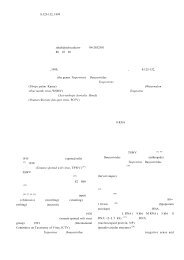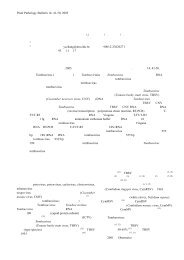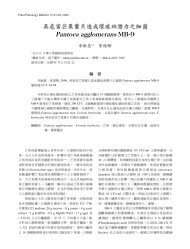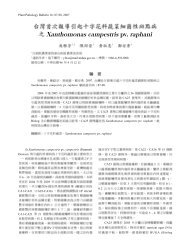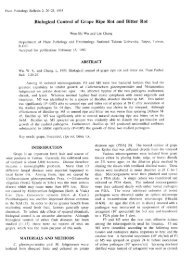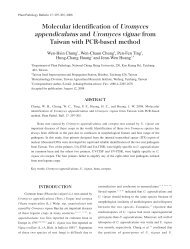calla lily (Araceae) (Zantedeschia) (Z. aethiopica) (rhizomatous ...
calla lily (Araceae) (Zantedeschia) (Z. aethiopica) (rhizomatous ...
calla lily (Araceae) (Zantedeschia) (Z. aethiopica) (rhizomatous ...
Create successful ePaper yourself
Turn your PDF publications into a flip-book with our unique Google optimized e-Paper software.
Plant Pathology Bulletin 14:239-250, 2005<br />
(<strong>Zantedeschia</strong>)<br />
1<br />
(19)<br />
(Z. <strong>aethiopica</strong>)<br />
1 1 1 1 1,2<br />
2 ycchang@ntu.edu.tw +886-2-23620271<br />
16<br />
. 14: 239-250.<br />
94 11 14<br />
<strong>calla</strong> <strong>lily</strong><br />
(<strong>Araceae</strong>)<br />
(7)<br />
. 2005.<br />
16 (Dasheen mosaic virus, DsMV)<br />
DsMV DsMV DsMV<br />
(DsMV-ZAN) cDNA<br />
DsMV DsMV<br />
(indirect-ELISA, I-ELISA) DsMV<br />
DsMV<br />
DsMV DsMV 3'<br />
DNA (dot-blot hybridization,<br />
DBH) RNA<br />
RNA<br />
DNA<br />
(immunocapture RT-PCR, IC-<br />
RT-PCR) DsMV I-ELISA DBH IC-RT-<br />
PCR IC-RT-PCR I-ELISA 125<br />
DBH I-ELISA 4 DBH IC-RT-PCR DsMV<br />
ELISA DsMV<br />
(<strong>Zantedeschia</strong> spp.)<br />
(tuber)<br />
(<strong>rhizomatous</strong>)
240<br />
(6)<br />
20<br />
DsMV)<br />
(Dasheen mosaic virus,<br />
(26) (Cucumber mosaic virus,<br />
CMV) (23) (<strong>Zantedeschia</strong> mosaic virus,<br />
ZaMV) (20) (Bean yellow mosaic<br />
virus, BYMV) (25) (Konjak mosaic virus,<br />
KoMV) (25) (Tomato spotted wilt<br />
virus, TSWV) (25) (Impatiens<br />
necrotic spot virus, INSV) (25) (Alfalfa<br />
mosaic virus, AMV) (25) X (Potato virus X,<br />
PVX) (25) (Arabis mosaic virus, ArMV) (25)<br />
(7)<br />
(1, 7)<br />
(Tobacco rattle virus, TRV) (25)<br />
DsMV (16) ZaMV (9)<br />
(Turnip mosaic virus, TuMV) (13)<br />
(Carnation mottle virus, CarMV) (15)<br />
mosaic virus, ZaMMV)<br />
(<strong>Zantedeschia</strong> mild<br />
(18) (Calla <strong>lily</strong><br />
chlorotic spot virus, CCSV) (14) (Calla<br />
<strong>lily</strong> latent virus, CLLV) (12) 16<br />
(2, 16, 22)<br />
DsMV<br />
DsMV<br />
16<br />
DsMV Potyviridae Potyvirus<br />
(Colocasia esculenta)<br />
700-800 nm<br />
1970 Zettler<br />
(Aphis craccivora) (A.<br />
gossypii) (Myzus persicae)<br />
(33) DsMV<br />
14 4 2005<br />
(34)<br />
(34) DsMV<br />
(35)<br />
(4, 5, 8, 26, 35) DsMV (Dieffenbachia spp.)<br />
(10, 11, 32)<br />
(Spathiphyllum spp.)<br />
(34) (Aglaonema spp.)<br />
(10, 34) (Caladium spp.)<br />
(Xanthosoma spp.) (feathering)<br />
DsMV<br />
(34, 35, 36)<br />
(Philodendron selloum) DsMV<br />
(32)<br />
(5, 8, 32, 33, 35)<br />
DsMV (32, 33, 34) DsMV<br />
DsMV<br />
DsMV<br />
(33, 34) DsMV<br />
60% (33, 34) DsMV<br />
DsMV<br />
DsMV<br />
DsMV (DsMV-TW)<br />
DsMV<br />
(DsMV-ZAN) (DsMV-ZAE) 1.8 kb<br />
DsMV-ZAN DsMV-ZAE DsMV-<br />
TW DsMV-LA DsMV-TEN<br />
DsMV-Ch N (8)<br />
potyvirus<br />
PCR)<br />
DsMV<br />
(30)<br />
N<br />
DsMV<br />
(5, 8)<br />
DsMV<br />
DsMV-ZAN DsMV<br />
DsMV<br />
(indirect-ELISA, I-ELISA)<br />
(dot-blot hybridization, DBH)<br />
(immunocapture RT-PCR, IC-RT-<br />
(33)
(<strong>Zantedeschia</strong> spp.)<br />
DsMV (Agdia, Elkhart, IN, USA)<br />
Agdia<br />
DsMV 0.1 M sodium<br />
phosphate buffer (pH 7.2) (600 mesh)<br />
25<br />
ZaMV ZaMMV TuMV<br />
DsMV<br />
DsMV cDNA (pDsMV-ZAN8)<br />
(8) (DCPF1)<br />
(DCPR2) DCPR2 XhoI (<br />
) pDsMV-ZAN8 DsMV<br />
(8)<br />
952 bp 0.2 ml<br />
1 l pDsMV-ZAN8 (0.2 ng/ l)<br />
10 l 10X ThermoPol buffer (NEB, Beverly, MA,<br />
USA) 10 l dNTPs (2 mM) 10 l DCPF1 (5 M)<br />
10 l DCPR2 (5 M) 1 l Vent DNA polymerase (2<br />
U/ l, NEB, Beverly, MA, USA) 58 l H2O<br />
100 l GeneAmp ® PCR<br />
system 2400 (Applied Biosystems, Foster City, CA, USA)<br />
PCR 94 2 94 30<br />
52 45 72 60 35<br />
72<br />
1%<br />
7 PCR 5 l<br />
PCR XhoI<br />
GFXTM PCR DNA and<br />
Gel Band Purification Kit (Amersham Pharmacia Biotech,<br />
Piscataway, NJ, USA) XhoI DsMV<br />
DNA pET-29a(+) DNA (Novagen,<br />
Madison, WI, USA) XhoI EcoRV<br />
GFXTM Band Purification Kit<br />
PCR DNA and Gel<br />
DNA<br />
DsMV pET-29a(+) DNA<br />
(ligation) pET-DCP<br />
E. coli DH5 HB 101<br />
DsMV<br />
pET-DCP E. coli<br />
BL21(DE3) 50 ppm<br />
kanamycin 100 ml LB (1% tryptone, 0.5% yeast<br />
extract, 0.5% NaCl) 37 4-5<br />
OD600 0.4-1<br />
500 l 12,000 rpm<br />
30 50<br />
l 1X SDS gel-loading buffer (50 mM Tris-HCl, pH<br />
6.8, 2% SDS, 0.1% bromophenol blue, 10% glycerol, 5%<br />
-mercaptoethanol) (23)<br />
isopropyl- -D-thiogalactopyranoside (IPTG)<br />
1 mM DsMV<br />
37 1 500 l<br />
12,000 rpm 30<br />
50 l SDS gel-loading buffer<br />
4 IPTG 1<br />
1 5 12% SDS-PAGE<br />
DsMV<br />
Table 1. Oligonucleotide primer sequences used in this study<br />
Primer1 Sequence2 DCPF1 5' GCGGATGATACAGTTGATGC 3'<br />
DCPR2 5' ATGCCTCGAGCTGCGGAGGTGCCATACCTAGC 3'<br />
DF0 5' AGGCTTGGTAAACAGRCCACAG 3'<br />
DF2 5' GACTTCTATGAGGTCAATTC 3'<br />
DF3 5' GCCATGATAGAAGCATGGGG 3'<br />
DR0 5' TTGAACACCGTGCACGAAGCATC 3'<br />
PCPF1<br />
1 F and R indicate forward and reverse primers, respectively.<br />
5'GGCCCGGTACGCCTTYGAYTTYTA3'<br />
2 Nucleotide Y at degenerate position represents C and T. Nucleotide R at degenerate position represents A and G. A created XhoI<br />
site at DCPR2 is underlined.<br />
241
242<br />
DsMV<br />
DsMV<br />
pET-DCP BL21(DE3)<br />
kanamycin LB 1<br />
mM IPTG<br />
10 ml 5 5,000 rpm 4<br />
5 1 ml 2<br />
mM EDTA 50 mM Tris-HCl (pH 8.0)<br />
1.5 ml lysozyme<br />
100<br />
15<br />
g/ml 0.1 ml 1% Triton X-100 30<br />
15<br />
12,000 rpm 4<br />
SDS gel-loading buffer SDS-PAGE<br />
DsMV<br />
DsMV HiTrapTM Chelating HP Columns (Amersham Pharmacia Biotech,<br />
Piscataway, NJ, USA)<br />
DsMV<br />
DsMV<br />
I-ELISA)<br />
14 4 2005<br />
(indirect-ELISA,<br />
I-ELISA DsMV<br />
(titer)<br />
(Elkhart, IN, USA)<br />
Agdia<br />
10 indirect<br />
sample extraction buffer (ISE buffer 15 mM Na2CO3, 35<br />
mM NaHCO3, 2% polyvinylpyrrolidone (MW 40,000), pH<br />
9.6)<br />
1.5 ml 5,000 rpm 5<br />
100 l<br />
96 3<br />
ISE buffer DsMV<br />
(parafilm)<br />
37 1 1X<br />
PBST buffer (137 mM NaCl, 8 mM Na2HPO4, 1.5 mM<br />
KH2PO4, 2.7 mM KCl, 0.05% Tween-20, pH 7.4) 6<br />
100 l coating buffer (15<br />
mM Na2CO3, 35 mM NaHCO3, pH 9.6) 1%<br />
37<br />
1 PBST buffer 6<br />
ECI buffer (1X PBST buffer, 0.2%<br />
bovine serum albumin, 2% polyvinylpyrrolidone, pH 7.4)<br />
DsMV 100 l<br />
4 PBST buffer<br />
6 100 l ECI buffer 1000<br />
(alkaline phosphataseconjugated<br />
goat anti-rabbit IgG; Chemicon, Temecula,<br />
CA, USA) 37<br />
1 PBST buffer 6<br />
100 l PNP buffer (9.7%<br />
diethanolamine, 0.5 mM MgCl , pH 9.8) 2 pnitrophenyl<br />
phosphate (PNP)<br />
40<br />
(1 mg/ ml)<br />
37<br />
(Spectra MAX 340, Molecular Devices Co., Berkeley, CA,<br />
USA) 405 nm<br />
(Immunoblot analysis)<br />
(28)<br />
Molecular Cloning<br />
12% SDS-<br />
PAGE PVDF (Osmonics,<br />
Westborough, MA, USA) 3%<br />
PBS buffer 37 30<br />
PBST buffer 10 2<br />
1X gelatin-NET (0.25% gelatin, 0.15 M NaCl, 5 mM<br />
EDTA, 0.05% Tween-20, 50 mM Tris-HCl, pH 8.0)<br />
8000 DsMV 37 2<br />
PBST 10 2<br />
1X gelatin-NET 1000<br />
NBT/BCIP<br />
Science, Mannheim, Germany)<br />
TE buffer<br />
(Roche Applied<br />
DsMV<br />
DsMV<br />
(DF0 DF2 PCPF1) (DR0) ( )<br />
pDsMV-ZAN8<br />
PCR DsMV<br />
PCR 2 l pDsMV-ZAN8 (0.2<br />
ng/ l) 2 l 10X PCR buffer 2 l dNTPs (2 mM)<br />
1 M (5 M) 1 M (5 M)<br />
11.5 l H2O 0.5 l DyNAzymeTM II DNA polymerase<br />
(2 U/ l, Finnzymes Inc., Espoo, Finland)<br />
20 l PCR 94 2<br />
94 30 52 30 72 30 35<br />
72 7 3 l<br />
PCR 1.5%
PCR 100<br />
PCR 1X<br />
PCR DIG labeling mix (Roche Applied Science,<br />
Mannheim, Germany) dNTPs<br />
PCR 2 l PCR<br />
-80<br />
1.5%<br />
(dot-blot hybridization, DBH)<br />
pDsMV-ZAN8 DF0/DR0<br />
PCR GeneQuant II RNA/DNA Calculator<br />
(Pharmacia Biotech Ltd., Piscataway, NJ, USA)<br />
1 ng/ l H2O 5<br />
DsMV<br />
ammonium carbonate buffer (200 mM<br />
ammonium carbonate, 2% SDS, 2 mM disodium EDTA,<br />
0.02% bentonite, pH 9.0) (17) RNA<br />
(3) RNA DEPC (diethyl<br />
pyrocarbonate) (DEPC-H2O) 4 l<br />
RNA 1%<br />
200 ng/ l DEPC-H2O 5<br />
10 ISE buffer<br />
1 ISE<br />
buffer 5 20X SSC (3 M NaCl,<br />
0.3 M sodium citrate, pH 7.0)<br />
Bedford, MA, USA)<br />
(Millipore,<br />
PCR (1 l) RNA (2 l)<br />
(5 l)<br />
UV<br />
(50% formamide, 5X SSC (v/v), 2% blocking<br />
reagent (w/v), 0.1% N-lauroylsarcosine (w/v), 0.02% SDS<br />
(w/v); Roche Applied Science, Mannheim, Germany)<br />
68 1 500 ng DIG<br />
55<br />
12<br />
(Roche Applied<br />
Science, Mannheim, Germany)<br />
(immunocapture RT-PCR, IC-RT-PCR)<br />
DF3 (<br />
DR0<br />
) IC-RT-PCR<br />
Wetzel<br />
(31)<br />
DsMV coating buffer 8,000<br />
100 l 0.5 ml 4<br />
DsMV<br />
10 general extraction buffer (GE<br />
buffer, Agdia, Elkhart, IN, USA)<br />
1.5 ml<br />
5,000 rpm 10<br />
0.5 ml<br />
200 l PBST buffer 3<br />
100 l 37<br />
1 200 l PBST buffer 3<br />
65 1% Triton X-100<br />
(10 l) 5 l DEPC-H2O 5 l<br />
AMV RT 5X reaction buffer (Promega, Madison, WI,<br />
USA) 1 l DR0 (5 M) 2.5 l dNTPs (10<br />
mM) 0.5 l rRNasin (40 U/ l , Promega, Madison,<br />
WI, USA) 1 l AMV reverse transcriptase (10 U/ l,<br />
Promega, Madison, WI, USA)<br />
cDNA<br />
42 1<br />
PCR 0.2 ml 11.5 l<br />
ddH2O 2 l 2 l 10X PCR buffer 2 l<br />
dNTPs (2 mM) 1 l DR0 (5 M) 1 l DF3<br />
(5 M) 0.5 l DyNAzymeTM II DNA polymerase<br />
20 l 1,000 rpm 10<br />
PCR 94 2<br />
94 1 52 1 72 1 35<br />
72 10 10 l<br />
PCR 1%<br />
I-ELISA DBH IC-RT-PCR<br />
DsMV<br />
5 GE buffer<br />
1.5<br />
ml 5,000 rpm 10<br />
I-ELISA DBH<br />
ISE buffer 5 IC-RT-<br />
PCR GE buffer 5<br />
I-ELISA 8000 DsMV<br />
DBH DN457 IC-RT-PCR<br />
DsMV<br />
DsMV-ZAN<br />
(8)<br />
243
244<br />
(DCPF1)<br />
(DCPR2) ( ) 952<br />
bp<br />
pET-29a(+)<br />
DNA DNA<br />
pET-DCP ( ) pET-DCP<br />
E. coli BL21(DE3)<br />
kanamycin LB 1 mM IPTG<br />
DsMV 39 kDa SDS-<br />
PAGE 36.5 kDa<br />
55.4 kDa DsMV<br />
IPTG 1<br />
3 ( ) 10 ml 3<br />
( )<br />
HiTrapTM Chelating HP Columns<br />
DsMV<br />
DsMV<br />
14 4 2005<br />
pET-DCP BL21 (DE3) IPTG<br />
12% SDS-PAGE<br />
M Mark12 TM Unstained Standard (Invitrogen,<br />
Carlsbad, CA, USA) 1 IPTG 2<br />
5 IPTG 1 4<br />
Fig. 1. E. coli BL21 (DE3) transformed with pET-DCP<br />
was harvested at different IPTG induction time and<br />
analyzed by electrophoresis in a 12% sodium dodecyl<br />
sulfate polyacrylamide gel (SDS-PAGE). Lane M,<br />
Mark12 TM Unstained Standard (Invitrogen, Carlsbad, CA,<br />
USA); lane 1, no IPTG induction; lanes 2-5, one to four<br />
hours after IPTG induction. Molecular weights of the<br />
markers are indicated on the left. The predicted position of<br />
the expressed protein is indicated by an arrow and the<br />
number is the deduced molecular weight.<br />
DsMV<br />
DsMV I-ELISA<br />
DsMV DsMV<br />
ECI buffer 500 1000 2000 4000 8000<br />
16000 32000<br />
DsMV<br />
ELISA<br />
I-ELISA<br />
32000<br />
DsMV ( )<br />
DsMV DsMV<br />
DsMV 8000<br />
DsMV I-ELISA<br />
I-ELISA 8000 DsMV<br />
Fig. 2. Titer of DsMV antiserum analyzed by I-ELISA.<br />
DsMV-infected and healthy <strong>calla</strong> lilies were used as test<br />
samples. Different dilutions of DsMV antiserum were<br />
used as first antibody and alkaline phosphatase-conjugated<br />
goat anti-rabbit IgG was used as secondary antibody. Each<br />
dilution had triplet wells. The absorbance was measured<br />
40 min after the addition of PNP substrate.<br />
DsMV<br />
DsMV<br />
ZaMV TuMV ZaMMV<br />
DsMV SDS-<br />
PAGE<br />
DsMV 36 kDa<br />
DsMV DsMV (39<br />
kDa) ( ) N
12% SDS-PAGE<br />
PVDF<br />
1 2<br />
PageRulerTM Prestained Protein Ladder (Fermentas,<br />
Hanover, MD, USA) 3 7<br />
Fig. 3. Specificity of DsMV antiserum analyzed by<br />
Immunoblot analysis. Expressed coat protein and crude<br />
sap extracts of <strong>calla</strong> lilies were separated by 12% SDS-<br />
PAGE and transferred to a PVDF membrane and reacted<br />
with DsMV antiserum. Lane 1, purified recombinant coat<br />
protein of DsMV; lane 2, PageRuler TM Prestained Protein<br />
Ladder (Fermentas, Hanover, MD, USA); lanes 3-7,<br />
healthy, DsMV-infected, TuMV-infected, ZaMV-infected,<br />
and ZaMMV-infected <strong>calla</strong> <strong>lily</strong> extract, respectively. The<br />
native (36 kDa) and recombinant (39 kDa) coat proteins of<br />
DsMV are indicated by arrows.<br />
30 C 6 histidine<br />
DsMV<br />
DsMV<br />
DsMV<br />
ZaMV TuMV ZaMMV<br />
DBH DsMV<br />
( )<br />
pDsMV-ZAN8 DNA<br />
DR0/DF0 DR0/DF2 DR0/PCPF1<br />
PCR 250 457 474 bp DNA<br />
DsMV DNA<br />
DN250 DN457 DN474 DsMV<br />
RNA DBH<br />
DsMV RNA<br />
ZaMV RNA<br />
245<br />
( ) DsMV<br />
DNA 64 fg DsMV PCR<br />
640 pg DsMV<br />
DsMV DNA<br />
RNA ( )<br />
pDsMV-ZAN8 PCR<br />
RNA H2O<br />
5<br />
DN250 DN457 DN474<br />
Fig. 4. The specificity and sensitivity of three DsMV DNA<br />
probes analyzed by dot-blot hybridization (DBH). PCR<br />
product of pDsMV-ZAN8 amplified by DF0/DR0 primers<br />
was used as positive control (+). Total RNAs purified from<br />
healthy (H), DsMV-infected (D) and ZaMV-infected (Z)<br />
Philodendron selloum were used as test samples. Positive<br />
control and three types of total RNA were 5-fold serially<br />
diluted with H2O. And then 1 l of positive control and 2<br />
l of total RNA were separately dotted on nylon<br />
membranes. The membranes were hybridized with DsMV<br />
DNA probes, DN250, DN457, and DN474, respectively.<br />
The original concentration (dot 1) of positive control was<br />
1 ng/ l and that of total RNA was 200 ng/ l. Amount of<br />
positive control applied (dots 1 to 8) was 1 ng, 200 pg, 40<br />
pg, 8 pg, 1.6 pg, 320 fg, 64 fg and 12.8 fg, respectively.<br />
Amount of total RNA applied (dots 1 to 8) was 400 ng, 80<br />
ng, 16 ng, 3.2 ng, 640 pg, 128 pg, 25.6 pg and 5.12 pg,<br />
respectively.
246<br />
5 -1 5 -7 5 l<br />
DN250 DN457 DN474<br />
ISE buffer<br />
DsMV DNA DsMV<br />
ZaMV<br />
( )<br />
DsMV DNA 5 -3 5 -4<br />
DsMV ( ) DsMV DNA<br />
DsMV PCR<br />
RNA (<br />
)<br />
14 4 2005<br />
pDsMV-ZAN8 PCR<br />
ISE<br />
buffer 5<br />
DN250 DN457 DN474<br />
Fig. 5. Evaluation of the specificity and sensitivity of<br />
DBH for detection of DsMV in crude sap extracts. PCR<br />
product of pDsMV-ZAN8 amplified by DF0/DR0 primers<br />
was used as positive control (+) as described in fig. 4.<br />
Healthy (H), DsMV-infected (D) and ZaMV-infected (Z)<br />
P. selloum were separately ground in 10 volumes of ISE<br />
buffer and the clarified supernatants were used as the<br />
original crude sap extracts (dot 1). Crude sap extracts were<br />
5-fold serially diluted with ISE buffer and 5 l was<br />
dotted on nylon membranes. The membranes were<br />
hybridized with DsMV DNA probes, DN250, DN457, and<br />
DN474, respectively.<br />
I-ELISA DBH IC-RT-PCR<br />
IC-RT-PCR<br />
DsMV GE buffer<br />
ISE buffer GE buffer<br />
5 -1 5 -8 I-ELISA DBH<br />
IC-RT-PCR 5 -8<br />
1426 bp ( -C)<br />
ELISA 5 -5 ( -A) DBH<br />
5 -4 ( -B)<br />
(ELISA 100 l,<br />
DBH 5 l, IC-RT-PCR 100 l)<br />
ELISA<br />
4<br />
125<br />
IC-RT-PCR<br />
DBH ELISA<br />
DsMV<br />
(4, 5, 8, 26, 35) DsMV<br />
(33, 34) DsMV<br />
ELISA<br />
DsMV<br />
(21, 27)<br />
I-ELISA<br />
DsMV<br />
DBH<br />
IC-RT-PCR<br />
DsMV<br />
I-ELISA DsMV<br />
(5, 8, 21) DsMV<br />
(DsMV-Ch)<br />
DsMV<br />
DsMV<br />
(21)<br />
DsMV I-ELISA<br />
DsMV I-ELISA<br />
DBH<br />
DsMV DNA<br />
DsMV RNA 640 pg<br />
DsMV<br />
DBH DNA
I-ELISA IC-RT-PCR<br />
(A) I-ELISA 5 -1 5 -8 (1<br />
8 ) (9 ) buffer (10 ) (B)<br />
(1 8 )<br />
(9 ) (10 ) (C) IC-RT-PCR<br />
(1 8 ) (9 )<br />
(10 )<br />
Fig. 6. Comparison of the sensitivities of I-ELISA, DBH<br />
and IC-RT-PCR for detection of DsMV in crude sap<br />
extracts. Infected P. selloum tissues were used to prepare<br />
original crude sap extract for DsMV detection. (A)<br />
I-ELISA analysis of different dilutions of original crude<br />
sap extract (5 -1 , 5 -2 , 5 -3 , 5 -4 , 5 -5 , 5 -6 , 5 -7 and 5 -8 -fold,<br />
respectively) (lanes 1-8), healthy control (lane 9), and<br />
buffer control (lane 10). The values indicate the<br />
absorbance at 405 nm after substrate incubation for 40<br />
min. (B) DBH analysis of the same set of crude sap<br />
extracts (dots 1-8), healthy control (dot 9), and positive<br />
control (dot 10) with DN457 probe. (C) IC-RT-PCR<br />
analysis of the same set of crude sap extracts (lanes 1-8),<br />
healthy control (lane 9), and positive control (lane 10).<br />
Lane M, 1 kb Plus DNA Ladder (Invitrogen, Carlsbad,<br />
CA, USA). The expected 1426-bp amplification product is<br />
indicated by arrow.<br />
RNA<br />
RNA<br />
Wetzel<br />
12X SSC 6% formaldehyde DsMV<br />
( ) DsMV<br />
(31)<br />
ISE buffer<br />
cold extraction buffer (50 mM sodium citrate,<br />
5 mM EDTA, pH 8.5) (29)<br />
5 -7<br />
ELISA<br />
ELISA<br />
RT-PCR<br />
IC-RT-PCR ELISA<br />
1000-5000 (24, 31) 625<br />
RT-PCR 250 (31) DsMV<br />
IC-RT-PCR DBH<br />
I-ELISA IC-RT-PCR<br />
I-ELISA 125<br />
(24, 31) PCR<br />
(1426 bp 243-586 bp)<br />
IC-RT-PCR DBH<br />
I-ELISA 4 Sanchez-Navarro<br />
5-25<br />
(29)<br />
IC-RT-PCR<br />
DsMV<br />
RNA<br />
I-ELISA<br />
I-ELISA<br />
-1.1.2- -X2)<br />
RNA<br />
DsMV<br />
ELISA<br />
IC-RT-PCR<br />
DsMV<br />
DBH<br />
(91<br />
247
248<br />
14 4 2005<br />
(LITERATURE CITED)<br />
1. . 1999.<br />
. 139: 40-41.<br />
2. . 1988.<br />
. 30: 422.<br />
3. . 2005.<br />
. 14: 41-50.<br />
4. . 2003. . p.55-62.<br />
12 .<br />
.<br />
5. . 1998.<br />
potyvirus<br />
. .<br />
130 pp.<br />
6.<br />
. 2001.<br />
. p.137-149.<br />
.<br />
7.<br />
. 2003. . p.2-7.<br />
12 .<br />
.<br />
8. . 1999.<br />
.<br />
. 131 pp.<br />
9. Chang, Y.-C. Chen, Y.-L., and Chung, F.-C. 2001.<br />
Mosaic disease of <strong>calla</strong> <strong>lily</strong> caused by a new potyvirus<br />
in Taiwan. Plant Dis. 85: 1289.<br />
10. Chase, A. R. 1987. Dasheen mosaic virus of aroids.<br />
Pages 64-65 in: Compendium of Ornamental Foliage<br />
Plant Diseases. A. R. Chase ed. APS Press. St. Paul,<br />
MN, USA. 92 pp.<br />
11. Chase, A. R., and Zettler, F. W. 1982. Dasheen mosaic<br />
virus infection of dieffenbachia cultivars. Plant Dis.<br />
66: 891-893.<br />
12. Chen, C.-C., Chang, C.-A., Tsai, H.-T., and Hsu, H. T.<br />
2004. Identification of a potyvirus causing latent<br />
infection in <strong>calla</strong> lilies. Plant Dis. 88: 1046.<br />
13. Chen, C.-C., Chao, C.-H., Chen, C.-C., Yeh, S.-D.,<br />
Tsai, H.-T., and Chang, C.-A. 2003. Identification of<br />
Turnip mosaic virus isolates causing yellow stripe and<br />
spot on <strong>calla</strong> <strong>lily</strong>. Plant Dis. 87: 901-905.<br />
14. Chen, C.-C., Chen, T.-C., Lin, Y.-H., Yeh, S.-D., and<br />
Hsu, H. T. 2005. A chlorotic spot disease on <strong>calla</strong> lilies<br />
(<strong>Zantedeschia</strong> spp.) is caused by a tospovirus<br />
serologically but distantly related to Watermelon silver<br />
mottle virus. Plant Dis. 89: 440-445.<br />
15. Chen, C.-C., Ko, W.-F., Lin, C.-Y., Jan, F.-J., and Hsu,<br />
H. T. 2003. First report of Carnation mottle virus in<br />
<strong>calla</strong> <strong>lily</strong> (<strong>Zantedeschia</strong> spp.). Plant Dis. 87: 1539.<br />
16. Chen, Y.-L., Chung, F.-C., and Chang, Y.-C. 1998.<br />
Molecular cloning and characterization of dasheen<br />
mosaic potyvirus from aroid plants in Taiwan. Plant<br />
Pathol. Bull. 7: 226-227.<br />
17. Donald, R. G. K., and Jackson, A. O. 1994. The barley<br />
stripe mosaic virus b gene encodes a multifunctional<br />
protein that affects pathogenesis. Plant Cell 6: 1593-<br />
1606.<br />
18. Huang, C.-H., and Chang, Y.-C. 2005. Identification<br />
and molecular characterization of <strong>Zantedeschia</strong> mild<br />
mosaic virus, a new <strong>calla</strong> <strong>lily</strong>-infecting potyvirus.<br />
Arch. Virol. 150: 1221-1230.<br />
19. Kuehny, J. S. 2000. Crop reports: Calla history and<br />
culture. HortTechnology 10: 267-274.<br />
20. Kwon, S B., Ha, J. H., Yoon, J. Y., and Ryu, K. H.<br />
2002. <strong>Zantedeschia</strong> mosaic virus causing leaf mosaic<br />
symptom in <strong>calla</strong> <strong>lily</strong> is a new potyvirus. Arch. Virol.<br />
147: 2281-2289.<br />
21. Li, R. H., Zettler, F. W., Purcifull, D. E., and Hiebert,<br />
E. 1998. The nucleotide sequence of the 3'-terminal<br />
region of dasheen mosaic virus (Caladium isolate) and<br />
expression of its coat protein in Escherichia coli for<br />
antiserum production. Arch. Virol. 143:2461-2469.<br />
22. Liang, Y. G., Yang, T. C., and Chen C. T. 1994.<br />
Identification of dasheen mosaic virus in Taiwan by<br />
immunolabellings. Rept. Taiwan Sugar Res. Inst. 143:<br />
41-50.<br />
23. Mokra, V., and Gotzova, B. 1994. Identification of<br />
virus infections in Dieffenbachia and <strong>Zantedeschia</strong> in<br />
Czechoslovakia. Acta Hort. 377: 361-362.<br />
24. Mumford, R. A., and Seal, S. E. 1997. Rapid singletube<br />
immunocapture RT-PCR for the detection of two<br />
yam potyviruses. J. Virol. Methods 69:73-79.<br />
25. Pham, K., Langeveld, S. A., Lemmers, M. E. C., and<br />
Derks, A. F. L. M. 2002. Detection and identification<br />
of potyviruses in <strong>Zantedeschia</strong>. Acta Hort. 568: 143-<br />
148.<br />
26. Rana, G. L., Vovlas, C., and Zettler, F. W. 1983.<br />
Manual transmission of dasheen mosaic virus from<br />
Richardia to nonaraceous hosts. Plant Dis. 67: 1121-<br />
1122.<br />
27. Rodoni, B. C., and Moran, J. R. 1988. The detection of<br />
dasheen mosaic virus using the enzyme-linked<br />
immunosorbent assay (ELISA). Acta Hort. 234: 281-<br />
288.<br />
28. Sambrook, J., and Russell, D. W. 2001. Molecular<br />
Cloning, a Laboratory Manual, 3rd ed. Cold Spring<br />
Harbor Laboratory Press, Cold Spring Harbor, New<br />
York, USA.<br />
29. Sanchez-Navarro, J. A., Canizares, M. C., Cano, E. A.,<br />
and Pallas, V. 1999. Simultaneous detection of five<br />
carnation viruses by non-isotopic molecular<br />
hybridization. J. Virol. Methods 82: 167-175.<br />
30. Shukla, D. D., and Ward, C. W. 1989. Structure of
potyvirus coat proteins and its application in the<br />
taxonomy of the potyvirus group. Adv. Virus Res. 36:<br />
273-314.<br />
31. Wetzel, T., Candresse, T., Macquaire, G.,<br />
Ravelonandro, M., and Dunez, J. 1992. A highly<br />
sensitive immunocapture polymerase chain reaction<br />
method for plum pox potyvirus detection. J. Virol.<br />
Methods 39: 27-37.<br />
32. Zettler, F. W., Abo El-Nil, M. M., and Hartman, R. D.<br />
1978. Dasheen mosaic virus. CMI/AAB Descriptions<br />
of Plant Viruses No. 191. 4 pp.<br />
33. Zettler, F. W., and Hartman, R. D. 1986. Dasheen<br />
mosaic virus and its control in cultivated aroids. Food<br />
and Fertilizer Technology Center for Asia and Pacific<br />
249<br />
Region, Taipei, Taiwan, Republic of China. FFTC<br />
book No33. 11 pp.<br />
34. Zettler, F. W., and Hartman, R. D. 1987. Dasheen<br />
mosaic virus as a pathogen of cultivated aroids and<br />
control of the virus by tissue culture. Plant Dis. 71:<br />
958-963.<br />
35. Zettler, F. W., Foxe, M. J., Hartman, R. D.,<br />
Edwardson, J. R., and Christie, R. G. 1970.<br />
Filamentous viruses infecting dasheen and other<br />
araceous plants. Phytopathology 60: 983-987.<br />
36. Zettler, F. W., Tsai, J. H., Faan, H. C., Ke, C., and Lu,<br />
K. C. 1987. Dasheen mosaic virus infecting taro in<br />
People's Republic of China. Plant Dis. 71: 837-839.
250<br />
14 4 2005<br />
ABSTRACT<br />
Huang, W.-Z. 1 , Chung, F.-C. 1 , Chen, Y.-L. 1 , Huang, C.-H. 1 , and Chang, Y.-C. 1,2 2005. Development<br />
and comparison of three detection methods for <strong>calla</strong> <strong>lily</strong>-infecting Dasheen mosaic virus. Plant Pathol.<br />
Bull. 14: 239-250. ( 1 Department of Plant Pathology and Microbiology, National Taiwan University,<br />
Taipei, Taiwan; 2 Corresponding author, E-mail: ycchang@ntu.edu.tw. Fax: +886-2-23620271)<br />
Calla lilies (<strong>Zantedeschia</strong> spp.), belonging to the family <strong>Araceae</strong>, are perennial bulbous flowers.<br />
Because <strong>calla</strong> lilies are very popular among consumers and the cultivation areas continuously<br />
increase, they become important flower crops worldwide. The viral disease is one of the limiting<br />
factors for growing <strong>calla</strong> lilies and 16 viruses have been reported. Among these viruses, Dasheen<br />
mosaic virus (DsMV), a member of the genus Potyvirus, is an important and widely spread virus<br />
which can infect at least 16 genera of aroid plants. In this study, three detection methods were<br />
developed for <strong>calla</strong> <strong>lily</strong>-infecting DsMV (DsMV-ZAN). The first method was to detect the coat<br />
protein of DsMV. Based on the sequence of DsMV-ZAN isolate, specific primers were designed to<br />
amplify the full-length of coat protein gene, and then cloned into the expression vector. Recombinant<br />
DsMV coat protein was expressed by Escherichia coli and used as antigen to prepare DsMV<br />
antiserum. The result of indirect-ELISA (I-ELISA) indicated DsMV antiserum possessed good titer.<br />
Moreover, its specificity was proved by immunoblot analysis since it did not react with other <strong>calla</strong>infecting<br />
potyviruses. The second method was to detect DsMV RNA. Three primer pairs located in<br />
3'UTR and the coat protein region of DsMV were designed and used to prepare three DNA probes<br />
with different length. The results of dot-blot hybridization (DBH) demonstrated that all probes were<br />
highly specific and had similar sensitivities in detecting DsMV in crude sap extracts and purified total<br />
RNAs although the latter showed better result than the former. The third method, immunocapture-RT-<br />
PCR (IC-RT-PCR), was developed by combining the immunological and nucleic acid detection<br />
methods. When the sensitivity of I-ELISA, DBH and IC-RT-PCR was compared by detecting DsMV<br />
in crude sap extracts, the results indicated that IC-RT-PCR was about 125 times more sensitive than I-<br />
ELISA, and DBH was about 4 times more sensitive than I-ELISA. There is neither paper about<br />
detecting DsMV by DBH or IC-RT-PCR nor report about comparing ELISA with these methods<br />
published before. Therefore, the DsMV detection methods developed in this study can be applied to<br />
virus certification scheme of <strong>calla</strong> <strong>lily</strong> and help to produce healthy seedlings in Taiwan.<br />
Key words: <strong>calla</strong> <strong>lily</strong>, Dasheen mosaic virus, I-ELISA, dot-blot hybridization, IC-RT-PCR



